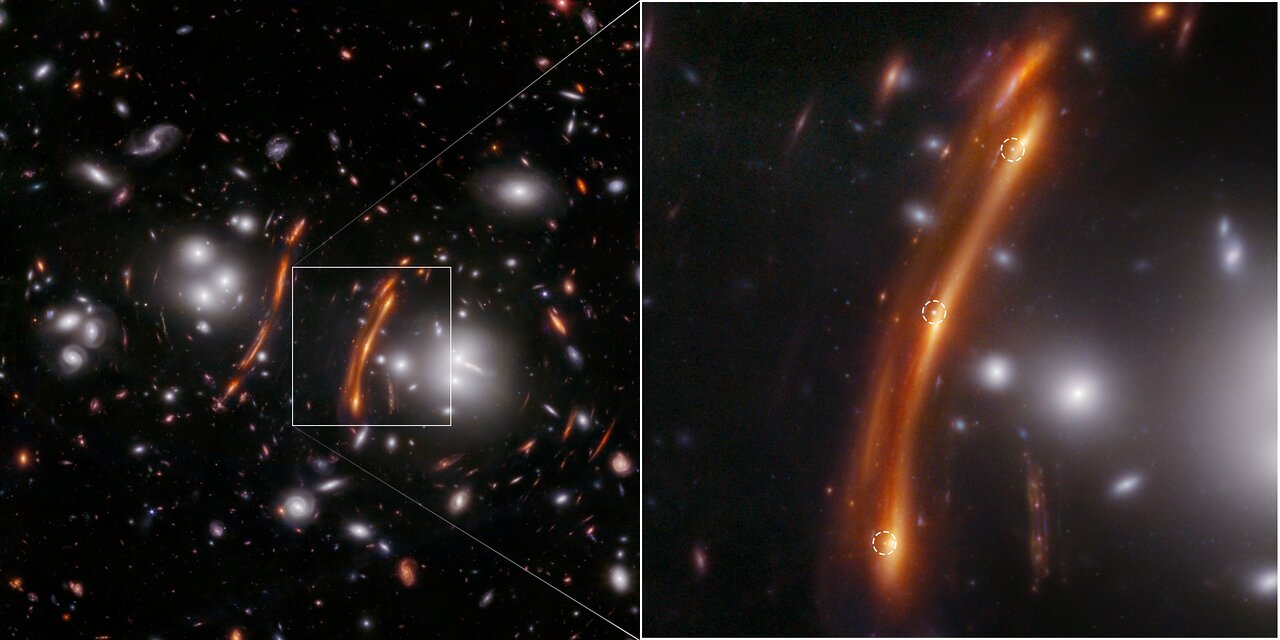SN H0pe
Webb researchers discover lensed supernova, confirm Hubble Tension
Measuring the Hubble constant, the rate at which the Universe is expanding, is an active area of research among astronomers around the world who analyze data from both ground- and space-based observatories. The NASA/ESA/CSA James Webb Space Telescope has already contributed to this ongoing discussion. Earlier this year, astronomers used Webb data containing Cepheid variables and Type Ia supernovae, reliable distance markers to measure the Universe’s expansion rate, to confirm the NASA/ESA Hubble Space Telescope’s previous measurements.
Now, researchers are using an independent method of measurement to further improve the precision of the Hubble constant — gravitationally lensed supernovae. Researchers from different institutions around the world are leading this effort after Webb’s discovery of three points of light in the direction of a distant and densely populated cluster of galaxies.
This is an image from Webb’s NIRCam (Near-Infrared Camera) of the galaxy cluster PLCK G165.7+67.0, also known as G165, on the left shows the magnifying effect a foreground cluster can have on the distant Universe beyond. The foreground cluster is 3.6 billion light-years away from Earth. The zoomed region on the right shows the supernova H0pe triply imaged (labeled with white dashed circles) due to gravitational lensing.
This field was selected for observation due to its high rate of star formation of more than 300 solar masses per year, an attribute that correlates with higher supernova rates. SN H0pe is one of the most distant Type Ia supernovae observed to date. The measured Hubble constant value matches other measurements in the local Universe, and is somewhat in tension with values obtained when the Universe was young. Future Webb observations in Cycle 3 will improve on the uncertainties.
In this image blue represents light at 0.9, 1.15, and 1.5 microns (F090W + F115W + F150W), green is 2.0 and 2.77 microns (F200W + F277W), and red is 3.56, 4.1, and 4.44 microns (F356W + F410M + F444W).
Note: This post highlights data from Webb science in progress, which has not yet been through the peer-review process.
[Image description: A two-panel image. In the left panel, dozens of small galaxies are scattered on the black background of space. Just to the left of the center, there is a long, red arc. At its left is a cluster of a few white galaxies that look like a glowing orb. To the right of the center, the red arc and glowing orb of galaxies at the left appear to be mirrored. The curved and distorted galaxy image on the right side is highlighted with a white box. Lines extend from the box’s corners to the right panel, which shows an enlarged view of the curved galaxy. Three faint points of light are circled.]
Links
- Blog on STScI website
- Published science paper
- Published science paper
- Published science paper
- Published science paper
- Published science paper
- Accepted science paper
- Observations programmes (JWST PEARLS)
NASA, ESA, CSA, STScI, B. Frye (University of Arizona), R. Windhorst (Arizona State University), S. Cohen (Arizona State University), J. D’Silva (University of Western Australia, Perth), A. Koekemoer (Space Telescope Science Institute), J. Summers (Arizona State University).
About the Image
| Id: | H0pe | |
|---|---|---|
| Type: | Collage | |
| Release date: | 1 October 2024, 17:15 | |
| Size: | 8816 x 4408 px | |


